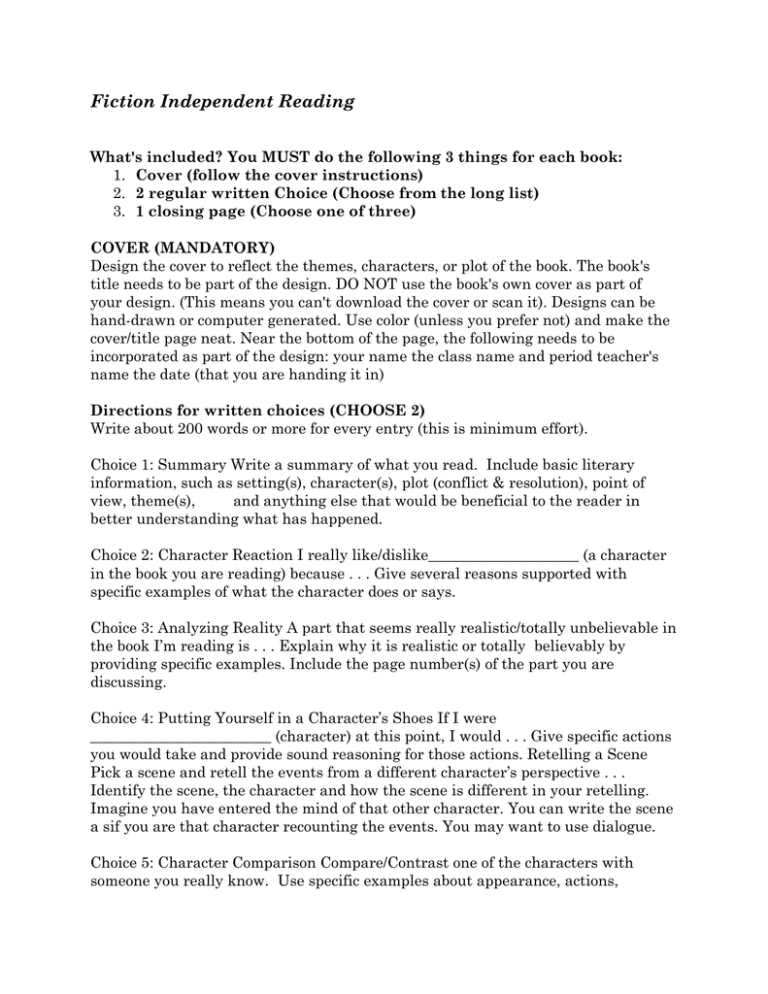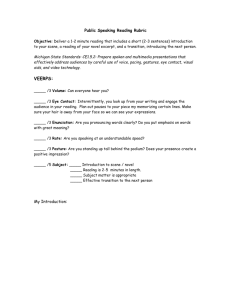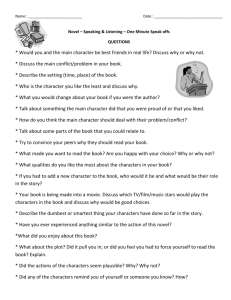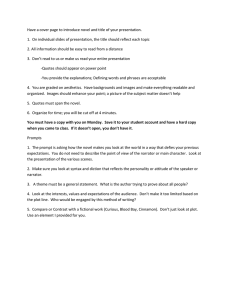Fiction Independent Reading Assignment Instructions
advertisement

Fiction Independent Reading What's included? You MUST do the following 3 things for each book: 1. Cover (follow the cover instructions) 2. 2 regular written Choice (Choose from the long list) 3. 1 closing page (Choose one of three) COVER (MANDATORY) Design the cover to reflect the themes, characters, or plot of the book. The book's title needs to be part of the design. DO NOT use the book's own cover as part of your design. (This means you can't download the cover or scan it). Designs can be hand-drawn or computer generated. Use color (unless you prefer not) and make the cover/title page neat. Near the bottom of the page, the following needs to be incorporated as part of the design: your name the class name and period teacher's name the date (that you are handing it in) Directions for written choices (CHOOSE 2) Write about 200 words or more for every entry (this is minimum effort). Choice 1: Summary Write a summary of what you read. Include basic literary information, such as setting(s), character(s), plot (conflict & resolution), point of view, theme(s), and anything else that would be beneficial to the reader in better understanding what has happened. Choice 2: Character Reaction I really like/dislike____________________ (a character in the book you are reading) because . . . Give several reasons supported with specific examples of what the character does or says. Choice 3: Analyzing Reality A part that seems really realistic/totally unbelievable in the book I’m reading is . . . Explain why it is realistic or totally believably by providing specific examples. Include the page number(s) of the part you are discussing. Choice 4: Putting Yourself in a Character’s Shoes If I were ________________________ (character) at this point, I would . . . Give specific actions you would take and provide sound reasoning for those actions. Retelling a Scene Pick a scene and retell the events from a different character’s perspective . . . Identify the scene, the character and how the scene is different in your retelling. Imagine you have entered the mind of that other character. You can write the scene a sif you are that character recounting the events. You may want to use dialogue. Choice 5: Character Comparison Compare/Contrast one of the characters with someone you really know. Use specific examples about appearance, actions, personality, likes/dislikes, vocabulary, etc. Support your examples with citations from your novel (page number). Choice 6: Advice Column Describe one of the problems faced by a character and write advice for him/her. You may choose to be serious or humorous. Use the letter format common to newspaper advice columns, where the person with the problem writes for advice and the adviser writes back. Often, the person seeking advice "disguises" his or her name with a descriptive name associated with the problem. Choice 7: Alternative Ending Write an alternative ending for one of the books you read. Try to maintain consistency with the author's style. You must actually write the ending and not simply describe it. Choice 8: New Vocabulary List 10 new and interesting words from your book (please identify which book they are from and the page number) and define them. Explain why each word is interesting to you. Choice 9: Meaningful Quotations Quote 2-3 passages that you really connect with. Include the page number found in parentheses. Explain what makes those quotations/passages so meaningful to you. Choice 10: Searching for Similes and Metaphors Find and write down 5 similes and 5 metaphors from your book. Label each as a simile or a metaphor (give the page number). Choose five of them and explain in detail why you choose them. Choice 11: Character Sketch Write a character sketch describing your favorite character. Tell what the character is like outside (age, gender, hair, etc.) and inside (personality). Pay more attention to the internal qualities of your character than to the external qualities. You may also draw a picture of this character if you wish. The drawing is in addition to the written sketch. Choice 12: Revising Tone Choose a passage from the book you are reading and rewrite it, changing words to change the tone. Identify the original tone and then select what type of tone you wish to use. For example, you could sound angry, sympathetic, satirical, etc. (Please identify which book the passage is from and the page number.) Choice 13: T-Shirt Design Create a T-shirt design to highlight significant characters, events of themes in the book. Include words or phrases on the shirt, and give a complete explanation on the side about what the shirt signifies. Choice 14: Fortune Cookies You are dining at a Chinese restaurant with 5 characters from the novel you read. On that particular night, the fortune cookies are amazingly appropriate. Tell what each fortune cookie said and why it was especially fitting to the character who received it. Don’t forget to include yourself! Choice 15: Transporting a Character Lift a character out of the book you are reading and drop him or her down in our school. Is the character a student, teacher, custodian, secretary, nurse, principal, cafeteria employee, etc.? Don’t change the character’s personality—just show what might happen if he or she became one of us. Choice 16: Which Character IsComing to Dinner? Invite one of the characters in your book to dinner, explaining why you chose that character above the others. Next, write a note to your mother telling her that you have invited someone to dinner. Describe the person to her; include a few dos and don’ts for her to follow so that your guest will feel at home. Choice 17: Casting the Movie Version You are the director in charge of filming the novel. How will you cast it? Name specific actors for the roles. How will you handle the camera? What do you have in mind for setting and sound? How will you use color? Why? Choice 18: Switching Settings Describe what would happen if you would change the setting of the novel you are reading. Be specific. Remember, setting is both time and place. Would characters change? Would the plot have to change? Explain! Choice 19: Post card to a Character Create a postcard for the novel following the directions below. ·The postcard is written from you to a character in the novel·The stamp represents the setting·The address is to a specific character in the novel·Message includes one really important incident and 5 details·Some specific indication of your opinion of the book is included·Tack on a postscript (P.S.)·The picture side has an attractive drawing with the title of the book and the author’s name. Choice 20: Travel Brochure Design a travel brochure for the book you read. Include a heading/title, pictures, a map, vivid descriptions, a list of things to do, interesting facts that relate to your novel, and historical information relating to your book. Use the area below for brainstorming, but turn in a brochure with this log. Closing Choices (CHOOSE 1): Letter to the Author Write a letter to the author posing questions about the book. Include at least ten questions. Be sure to start your letter with a greeting and some information about yourself and your reaction to the book. Follow correct business letter format. (This is a closing log selection only). Who Should Read This Book? Write at least 2 paragraphs on this topic: Why ___________ should (or should not) read this book. Give good reasons! Choose a specific person you know for this log. (This is a closing log selection only). Literary Analysis and Positive Review Using complete sentences and paragraphs (at least 3), explain why this is the best book you read this semester. Include literary information, such as writing techniques (ideas, organization, voice, word choice, sentence fluency, conventions), plot structure, characterization, symbolism, setting, imagery, and so on. Explain your personal interaction with the book or the impact this book had on you or your life. Finally, describe why you think others should read the book.(This is a fiction closing log selection only).


